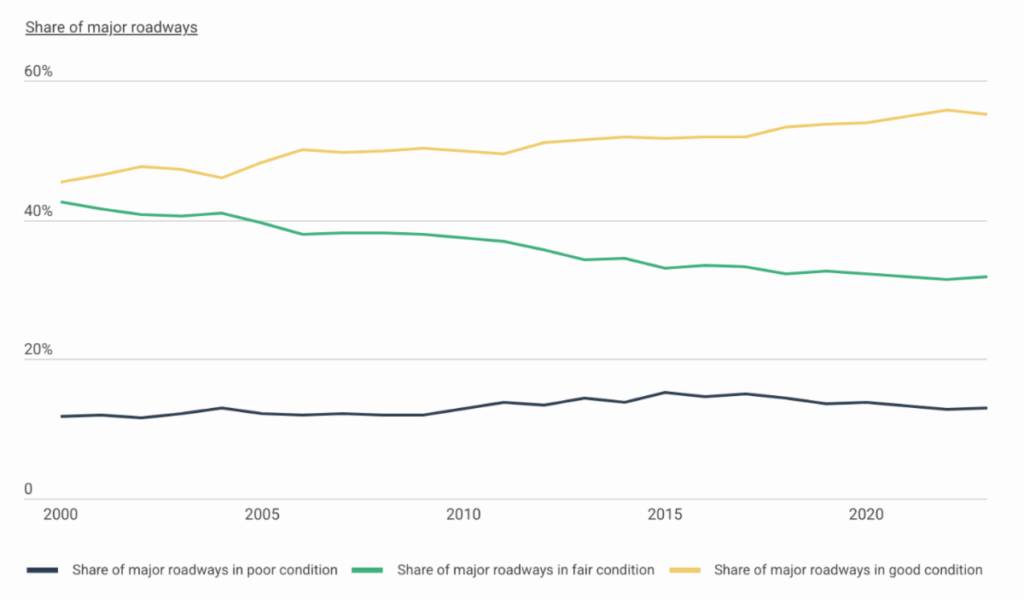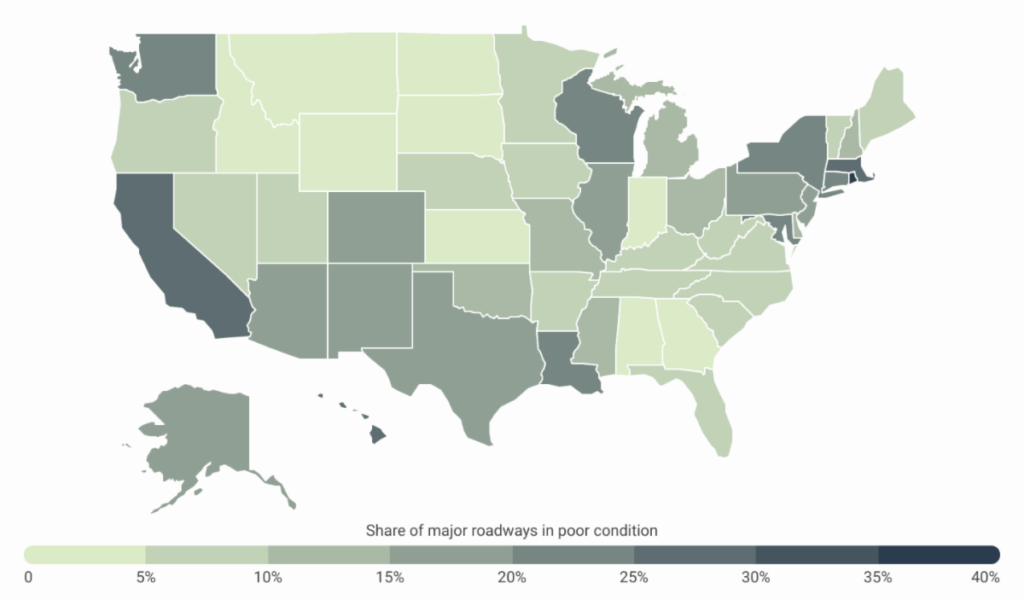Roadways are a vital component of infrastructure in the United States. The vast majority of goods are transported by truck, highlighting the economy’s need for reliable roadways to connect supply chains and move goods and services efficiently across borders. Most commuters use roads daily to get to work and individuals also rely on roadways for crucial access to resources, including employment, social, health and education services.
However, many highways, major roads and bridges are in need of repair. Hazardous road conditions can negatively impact the economy, contribute to traffic congestion, and impact the safety of Americans. The passing of the Infrastructure Investment and Jobs Act (also referred to as the Bipartisan Infrastructure Package) highlights the importance of reliable roads in the U.S., and the commitment to improving America’s infrastructure.
The 2021 bill signed by President Joe Biden dedicated $110 billion in funding to repair and update roads and bridges, in addition to supporting major transformational roadway projects across the U.S.
Highway & Street Construction Spending Over Time
Investment in America’s roadways skyrocketed in recent years
Source: Construction Coverage analysis of U.S. Census Bureau data | Image Credit: Construction Coverage
The passage of the Infrastructure Investment and Jobs Act came at a critical time. After adjusting for inflation, highway and street construction spending had largely stagnated for much of the previous decade. From 2010 to 2020, real spending hovered around $120 billion annually with little sustained growth—despite persistent infrastructure needs across the country.
The new federal investment helped reverse that trend. In constant 2025 dollars, monthly spending surged from about $120 billion in mid-2022 to nearly $150 billion in early 2025, providing renewed capacity to address long-standing maintenance backlogs and advance long-term transportation projects.
Trends in America’s Road Conditions
The share of roads in good condition has increased steadily

Source: Construction Coverage analysis of Federal Highway Administration data | Image Credit: Construction Coverage
Despite increased investment, many U.S. roads remain in poor shape. From 2000 to 2023, the share of major roadways in poor condition rose slightly—from 11.8% to 13.0%. At the same time, there has been clear progress: the share of roads in good condition increased by nearly 10 percentage points, reaching 55.2% in 2023, with noticeable improvements in the years following the 2021 infrastructure law.
The most significant shift occurred in the middle category. Roads classified as being in fair condition declined from 42.6% in 2000 to 31.8% in 2023. This suggests that many roads have either improved or worsened enough to move into a different category—reflecting a gradual but measurable change in overall road quality.
The Percentage of Roads in Poor Condition by State
The Northeast and California have the most roads in poor condition

Source: Construction Coverage analysis of Federal Highway Administration data | Image Credit: Construction Coverage
While public investment in roads is growing, many states continue to face significant maintenance challenges—particularly in the Northeast and along the West Coast. Rhode Island leads the nation, with 37.2% of its major roadways rated in poor condition—a slight improvement from years past. Other Northeastern states, including Massachusetts (27.0%), New York (23.7%), Maryland (21.2%), and Connecticut (20.4%), also rank among the worst. These states feature dense urban centers and high public transit use, yet still rely heavily on aging and heavily trafficked roadways.
Outside the Northeast, California reports 26.6% of its roads in poor condition, reflecting wear from its large, car-dependent population. Hawaii follows closely at 26.5%, despite its small population and geographic footprint.
In contrast, many Midwestern and Southern states report far lower shares of deteriorating roads. Kansas (2.9%), Wyoming (2.9%), and Indiana (2.7%) are among the best-performing states, highlighting a stark regional divide in infrastructure quality. Lower traffic volumes and a higher share of rural roads make maintaining highway infrastructure easier in many of these states.
Here is a summary of the data for Georgia:
- Share of major roadways in poor condition: 4.3%
- Share of major roadways in fair condition: 29.2%
- Share of major roadways in good condition: 66.5%
- Daily vehicle-miles traveled per capita: 31.4
For reference, here are the statistics for the entire United States:
- Share of major roadways in poor condition: 13.0%
- Share of major roadways in fair condition: 31.8%
- Share of major roadways in good condition: 55.2%
- Daily vehicle-miles traveled per capita: 26.6
Methodology
The data used in this analysis is from the U.S. Department of Transportation Federal Highway Administration’s 2023 Highway Statistics Series. To determine the states with the worst roads, researchers at Construction Coverage calculated the percentage of major roadways in poor condition using the latest data available. In the event of a tie, the state with the lower share of major roadways in good condition was ranked higher. Major roadways are defined to include interstates, other freeways and expressways, other principal arterials, and minor arterials. The International Roughness Index (IRI) was used to classify poor, fair, and good conditions of roadways by the following criteria:
- Poor: IRI greater than 170 inches/mile
- Fair: IRI between 95 and 170 inches/mile
- Good: IRI less than 95 inches/mile
The report is by Construction Coverage, a leading online publisher of construction industry research reports. Its work has been featured on CBS, Fox, USA Today, Bloomberg, Nasdaq, and more.
View the original article and our Inspiration here


Leave a Reply